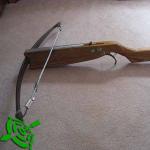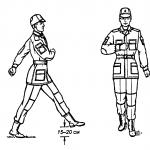Principles of combining running and bodybuilding. When is it better to run: in the morning or in the evening, before or after training? Running before or after strength training
What types of training do you prefer? Have you ever thought that an ingrained stereotype running training“not for the security forces” - just a myth? But in order for these two types of training to have an effect, you just need to combine them correctly.
Running training should be alternated with strength training, especially for those who started training at a conscious age. This type of load can eliminate the disadvantages of strength training - it uses muscle groups that do not “work” when running.
Big job of cardio-vascular system with minimal effort, which only increases the efficiency of training - the result of constant running loads. Why does this happen? Strength training is aimed at “building” the body (muscles), and running is aimed at increasing endurance. A huge plus of the above-mentioned type is that it has a beneficial effect on weight loss. Weightlifters note that running reduces the number of centimeters in the waist. If you have just begun to develop as an athlete, during the “drying” period, it will be simply irreplaceable.
A properly designed training schedule is the key to the success of a combination of two seemingly perfect different types training. These words are confirmed by a recent experiment in Australia, which only confirmed the conclusions that this training tandem gives obvious results.
The experimental group consisted of 15 people professionally involved in running, who also included in their daily exercise schedule power complexes. General high-intensity, aimed at training the legs, and low-intensity general training– categories into which additional loads were divided.
All study participants were measured 5-6 hours after training. The following conclusions were drawn:
— you should not plan important races earlier than 24 hours after strength training. Adequate break time should be at least 24 hours;
— strength training done at a moderate pace will not affect the quality of running;
- it is better to distribute time in such a way that running occurs in the first half of the day, and strength training, medium intensity, or bottom part bodies, to the second.
Running is contraindicated if your training is aimed at gaining muscle mass. The process of muscle growth requires a balance between stress and rest, and this is only possible if running in moderation and without acceleration.
Just remember that in your training calendar you need to include the time/days in which the body will be in a state of “rest”. Training and rest should also be balanced, as, in fact, the process of consumed and expended calories.
The positive dynamics of the final results noted by athletes gives every reason to say that spending time on a treadmill, with correct formation schedule only contributes to success.
Ruslan Dudnik
Font A A
This is not an easy topic - combining cardio and strength training. Eat different variants and each option has its own reasons.
Even about cardio itself there is a lot of controversy - some are sure that:
- cardio should be done daily
- some people think that 1-2 times a week is enough
- someone is completely against cardio
What can we say about combining strength training and cardio? Do cardio before strength training? After? Another day?
In order to understand this issue, I suggest first defining the difference between strength and cardio training.
Differences between strength and cardio exercise
- Goals strength training - increase in strength, volume and density of muscles, increase in strength (muscle) endurance.
- Cardio Training Goals- increasing endurance and fitness of the cardiovascular system (cardiovascular system).
In terms of calorie consumption, during the actual strength training or cardio workout, you don’t burn as many calories as you would like.
- But after strength training increased calorie expenditure persists throughout the day
- After cardio training increased calorie consumption stops within 20-60 minutes (according to various studies)
- Power training- triggers and accelerates anabolic processes in the body, subject to proper nutrition and rest
- Cardio training starts catabolic processes (exception - sprints)
Cardio has a weak effect on weight loss, since, based on the above, calories are spent mainly during training and their consumption immediately decreases after training, unlike strength training.
There are also nuances that make no sense to go into now, but briefly, for example:
- Sprints help build muscle mass, but they are much more difficult to master than strength exercises, the technique of which a beginner can master within a couple of weeks
- if you run a lot, you will undoubtedly lose weight, but the downside is that with long runs, catabolism processes also intensify, which reduces muscle tissue in the body
- It is most rational to reduce the percentage of body fat first of all with the help of diet, secondly with the help of strength training, and thirdly with the help of careful addition of cardio
Option 1 - cardio before strength training
Much depends on:
- intensity of classes
- your reaction to stress
- your training experience
I talked to people who went to the gym after a 30-40 minute run and did strength exercises for about an hour. These, of course, were a minority, but judging by their experience, strength and cardio indicators, appearance and well-being - for them this was the optimal regime.
Moreover, during the conversation they admitted that they tried other options - immediately after strength training or on a rest day - and the result was not very good.
Clarification - all of these people had at least 2-3 years of experience in strength training and cardio training, and many had trained significantly more (10 years or more).
So now why not use the option that works best for them for these people?
Moreover, I did not communicate with professional athletes, but with people whose main activity was of a different nature and often irregular. This:
- military personnel of different troops— I have lived in military camps since childhood, so I was always surrounded by military personnel from different types of troops
- law enforcement officers— thanks to my 12-year service in the Ministry of Internal Affairs, I was lucky enough to communicate with many interesting people from different units, including those who repeatedly participated in hostilities
- doctors, weather station workers, mountain tourists
All these people are very far from professional sports and glamorous fitness, and at the forefront of their preparation they set quite serious functional goals, so to speak. Of course, many people have a desire to look good, but this desire always goes hand in hand with the desire to become stronger, more resilient, more flexible, faster and more dexterous.
Therefore, we can make a reservation that option No. 1 is definitely not suitable for those people who have a zero level of general physical fitness.

Jokes aside, but if you excess weight, then there is a very high probability that as a result of running you will start to get sick quite quickly knee joints. The most rational thing to do in such a situation is to bring your weight back to normal, strengthen your joints with strength training, and only then start running.
But even if you are not overweight, you are not functional training, then even 10 minutes of running before strength training will lead to spots swimming before your eyes, red and out of breath, after the first strength exercise.
There is an opinion that 30 minutes of cardio before strength training will deplete glycogen reserves and then during strength training only fat will be used as an energy source. Only in life it turns out differently.
You spend all your energy on aerobic training and you simply don’t have the strength left to properly perform anaerobic (strength) training.
Therefore, we conclude that you should not discount the method of doing cardio before strength training just because few people do it.
Maybe this will be the best option for you, but only when you have already raised your general physical fitness level, and in general have been doing regular strength training for some time.
Be sure to try this option (cardio before strength training) when you become stronger and more resilient. Try it no earlier than after a year of regular training. It is possible that this option will be the best for you.
Option 2 - cardio after strength training
Cardio after strength training - by most people who are interested in fitness, it is considered the best way to lose weight through a combination of two types of activity (aerobic - cardio and anaerobic - strength).
When people ask me questions about whether such and such a method is good or bad, I often answer the question with a question - they say, what are your goals. Since, knowing the goal, you can choose the method that will lead you to it fastest.
- I want to lose weight, lose excess weight, reduce the percentage of body fat!
- Do you regulate your diet?
- Not yet.
- Then let's start with accounting for KBZHU.
And again - if you run after a strength training, thinking that this way you will lose weight faster, since during the strength training you have already exhausted all the glycogen, and during cardio the fat you hate will burn, then this is unlikely to be true.
If after strength training you have enough energy to do intense cardio training, maybe you are not finishing up on strength training? Maybe it makes sense to reconsider the load and train more effectively?
Under no circumstances should you judge the success of strength training by your condition after it.
Nobody says that after a strength training you need to crawl out of the gym, but going out so fresh that you have plenty of energy left to carry out a cardio workout of any duration and intensity is also not an option, would you agree?

The practical conclusion from all this can be drawn as follows: the option of performing cardio after strength training is again more suitable for experienced practitioners who clearly understand that the tasks of strength and cardio training are different.
If a beginner does this, then during strength training there is always a beacon in his mind that he will also have cardio, and this beacon simply will not give him the opportunity to give his best in strength training.
But you also need to take into account that a beginner cannot yet give his all in strength training, since the “brain-muscle” connection is not so strong yet, it is not possible to use them to the fullest. Therefore, you can often hear from beginners after strength training: “For some reason, I’m not very tired.”
Option 3 - cardio separately from strength training
Theoretically, this is the most ideal way. Practice shows that the theory is correct. This combination option is especially suitable for those who want to preserve muscles and burn fat.
- Anabolic and catabolic processes in this case will be separated in time
- Muscles will have time to recover after strength training
- And cardio training, in addition to strengthening the cardiovascular system, will help with additional calorie consumption and fat burning

Don't forget to monitor your pulse. It is believed that it is best to carry out cardio training at a level of 60-70% of the maximum heart rate (heart rate). Maximum heart rate is calculated using the formula: 220 - age.
Will there be losses? muscle tissue with this option of combining cardio and power loads? If you control your diet and your rest, then such losses can be minimized or avoided altogether.
Option 4 – high – interval training
Options interval training There are many. The main goal that many people pursue when doing interval training is to combine aerobic and anaerobic training.
Yes, such training makes maximum use of all body systems for the maximum amount of time. a short time.
Is fat burning increasing?
Increasing.
Does the increased calorie expenditure remain after such training?
Remains.

But such a high intensity is not 100% suitable for beginners and even for those who have been training for about six months. If your level of training is not below average, if you have already used a lot of reserves in your body, then you can try this kind of training, but no more than 2 times a week.
And the most important thing is that when you are ready for interval training, the experience that you will already have accumulated at that time and the level of awareness that you will have will allow you to make the right conclusion on your own regarding what type of interval training to try.
The most important conclusion
It all depends on your goals. Determine your goal in the field of physical self-improvement. Preferably one.
Choose ways to achieve it yourself or with the help of others.
And take action.
A person who achieves goals sequentially, one after another, always achieves greater results than a person who wants everything at once - to lose weight, and more muscles, and to do pull-ups many times, and to do the splits, and to become a vegetarian, and to do a triathlon... and .. and... and...
I wish you confidence in choosing your goals!
Sincerely, Ruslan Dudnik!
You can also run in different ways, you know, they set up barriers :)
To all lovers active image I dedicate this article to life, in which I will answer the question that interests many: What is more effective:? When we discussed best time for training, we briefly touched on the topic of cardio training, in particular running. Today website will reveal all the secrets running efficiently and will tell when is the best time to run to obtain the desired result depending on the goals.
And the goals could be the following:
- Fat burning and weight loss
- Drawing the relief
- Strengthening the cardiovascular system
- General maintenance of physical fitness, etc.
Usually girls are most interested in the first two goals: losing weight and working on relief. And right now we find out when is the best time to run if your goal is to burn fat? And what is better to choose: cardio before or after strength training her when it comes to .
And we’ll start, perhaps, with the very awakening and morning cardio.
Morning cardio on an empty stomach. All the pros and cons
If your goal is to build muscle mass, then it is better to do it 1.5-3 hours after you finish training with weights. During this time, glycogen in the muscles will be restored, protein synthesis will increase slightly, and its breakdown will stop - all this will have a positive effect on the growth of muscle mass and will give a positive effect from running.
Well, if your goal is weight loss, then this option is also good for you cardio after strength training. The main thing is not to overdo it with its duration, so as not to start the process of burning your muscles instead of fat. The optimal time is 15-20 minutes.
Well, now I am confident and calm that when the question arises in front of you, When is it better to run: morning or evening? Or what is more effective: cardio before or after workout? You will easily know the answers to all these questions and be able to choose the most suitable option for you personally, taking into account your goals and expected results from the planned cardio workout.
And, as always, your coach Janelia Skripnik was with you!
P.S. Effective cardio to everyone! =)
Running is the best way for burning fat, given to man by nature itself. Running nose to nose, lagging behind only to the bare minimum, is physical anaerobic exercise. This post will focus on running after strength training.
To avoid any misunderstanding, you need to immediately define what strength training is. Strength training is a workout whose goal is to increase the performance of one repetition with a maximum weight load. Increase strength indicators inherent in certain sports: weightlifting, bodybuilding, powerlifting, etc.
Strength training is designed to sculpt strong, beautiful body, and the body will only benefit if anaerobic exercise add cardioelements
Should you run after strength training?
If the goal is to get rid of excess fat deposits or, as people say, during the “drying” period, then cardio training is an effective remedy. As a rule, running after strength training is practiced during this period.
Will running interfere with weight gain? Why is it better to run after strength training?
It is preferable to do cardio training after strength exercises, because otherwise the body will get tired, and strength training will be covered with a copper basin.
Argument 1. As a result of cardio exercise, the muscles will be forced to use up glycogen, and therefore energy, which will become catastrophically lacking for strength training. There will be a release of cortisol, a hormone that extracts energy directly from muscle tissue, destroying it. The result of such strength training is a decrease in muscle mass.
Argument 2. Here is another argument in favor of “after”: since the muscles after strength training exhaust their entire glycogen supply, the body begins to pump out fat reserves from the very beginning of the cardio session. That is, running after strength training also has a significant fat-burning effect. Also, the advantages of jogging “after” include the ability to consolidate the results of weight exercises.
What are the disadvantages of running after strength training?
The disadvantages include the fact that jogging can significantly slow down the growth of muscle mass if you are an ectomorph or a transitional type between ectomorph and mesomorph (that is, thin build with a relatively small percentage of subcutaneous fat).
In addition, there is still a possibility of a negative impact on the recovery process if the intensity is incorrectly selected.

Incorrectly selected load during the jogging phase can slow down the process of restoring the body's resources due to exaggerated running intensity
Here we naturally move on to the next question.
When using the “strength training - jogging” combination, you need to be extremely careful. An incorrectly selected load during the jogging phase can significantly slow down the body’s recovery resources due to the exaggerated intensity of running, or may not give the desired result due to insufficient load.
Duration and intensity of cardio training after strength training
The intensity of the cardio session should be within the aerobic zone at a heart rate of 140-150 (this is the level at which the ability to maintain a conversation with a prospective partner should not be lost while running).
In terms of duration - focus on long-term loads of at least 30-40 minutes of continuous running. This regimen will ensure that you burn a fair amount of calories in addition to your strength training, while also burning some of your body fat.
Interval running for fat burning
You can try to realize the opportunity to spur fat-burning processes in the body, and thereby speed up metabolism, with the help of interval running. Interval running- this is an alternation of intense and calm jogging paces. This method is definitely a shake-up for the body, which will result in even greater weight loss. But the risk of overtraining with this approach increases significantly, since the body may not recover until the next workout if the load is calculated incorrectly and turns out to be excessive.
The treadmill does not necessarily have to be the highlight of the program; it may well be an addition to basic strength training.
What is the best way to combine the two types of load? In what order should I alternate them?
To begin with, let's remember the fundamental differences between exercises on the treadmill and, say, on the butterfly.
Cardio ensures the development of endurance (by training the cardiovascular and respiratory system), and at the same time helps burn fat deposits.
Strength training helps strengthen muscles, but also significantly contributes to weight loss - it accelerates anabolic processes for a long time.
It is important to consider several points:
- Excessively long non-interval runs stimulate catabolism, slowing down the growth of muscle tissue;
- pumping up muscles while running is possible (in particular, due to sprints), but only with the correct movement technique;
- In any case, losing weight through cardio alone is unacceptable - nutritional correction must be put at the forefront.
Jogging at the very beginning
Professional athletes and experienced bodybuilders, as a rule, do not run before strength training.
People who already have a good workout usually prefer to start an activity by jogging. physical fitness and exercise for the sake of preserving it (for example, military personnel, security forces, etc.).
Beginners should only get on the treadmill immediately upon arriving at the gym for a couple of minutes - for a warm-up run at a slow pace. A too active start will quickly exhaust a beginner. At the very first strength exercise, spots will appear before his eyes.
Treadmill after workout
The “cardio after strength training” option is much more universal.
It is justified, if only because when performing strength exercises, it is possible to use up glycogen reserves - while running, the body immediately has to use up long-term fat reserves.
Concluding the article, we emphasize that some athletes prefer not to mix cardio training with strength training, but to perform them on different days.
This method has significant advantages: anabolic and catabolic processes do not overlap each other, the muscles have time to recover.




